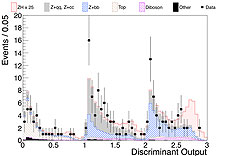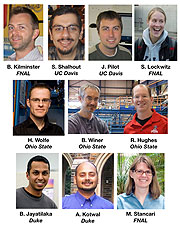Tools of the trade for Higgs boson searches
 |
| The three regions of background are present here: top-like events on the far left, Z+ jet-like events in the middle and Higgs-like events on the far right.
|
Higgs boson events are expected to be extremely rare at the Tevatron, so seeing evidence for the Higgs production requires keeping and analyzing every promising event. A team at CDF has worked to implement new tools aimed to do just that.
The CDF physicists searched for Higgs bosons produced along with Z bosons, in the so-called ZH channel. The selected Z bosons decay to two charged leptons, while the Higgs boson decay is expected to produce a pair of jets. This signature is shared by other processes that do not produce Higgs bosons, including Z+ jets and top quark pair events.
The ZH channel is efficient, since Higgs and Z decay products can be identified and measured with the detector, significantly reducing the background. The remaining background is still much larger than the expected ZH signal, and the challenge lies in separating the background events from the Higgs boson signal.
The separation is achieved by using a system of artificial neural networks - mathematical functions meant to mimic the human brain and its decision-making ability. The system is trained to decide whether an event looks like one containing a Higgs boson, or if it looks more like one of the other background processes. It does this by looking at the positions and energies of all the particles produced in the event. The results of this method can be seen in the plot above, used in the analysis to set limits on the amount of Higgs boson signal consistent with the observed data.
The CDF team observed a limit of 5.4 times the Standard Model predicted value for a Higgs boson mass of 120 GeV/c2. The expected value was 4.7 times this. These new tools of the trade for Higgs searches have had a big impact equivalent to increasing the number of expected Higgs events by roughly 50 percent.
The CDF Higgs team continues to squeeze out all the possible sensitivity to a Higgs boson signal, using the tools developed for this analysis.
Learn more
—Edited by Pasha Murat and Andy Beretvas
 |
| These physicists made major contributions to this analysis. Not shown: John Conway, UC Davis; Robin Erbacher, UC Davis, Rob Harr, Wayne State; and Paul Tipton, Yale.
|
|